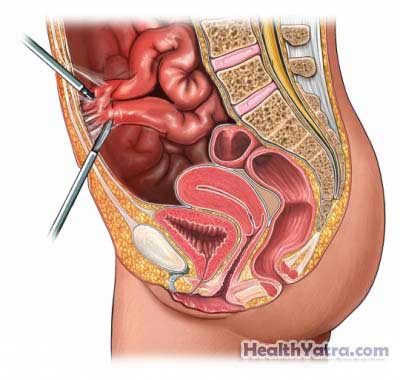تعريف
Adhesions are scars that form within the body. They usually form in the abdomen or pelvis. Adhesions develop naturally after surgery as part of the healing process. They can also develop after infection or any other inflammatory process, such as:
- بطانة الرحم
- التهاب الرتج
- التهاب الزائدة الدودية
Lysis of adhesions is the process of cutting scar tissue within the body. This is done to restore normal function and reduce pain.

أسباب هذا الإجراء
Adhesions can cause:
- الألم
- Obstruction of the bowel
- العقم
This surgery can fix intestinal blockage and treat infertility caused by adhesions. It also reduces chronic abdominal pain in some individuals.
المضاعفات المحتملة
Complications are rare, but no procedure is completely free of risk. If you are planning to have lysis of adhesions, your سيقوم الطبيب بمراجعة القائمة من المضاعفات المحتملة، والتي قد تشمل:
- Injury to organs
- Worse adhesions
- نزيف
- العدوى
تشمل العوامل التي قد تزيد من خطر حدوث مضاعفات ما يلي:
- Pre-existing heart or lung condition
- السمنة
- Major abdominal surgery in the past
- التدخين
- مرض السكري
تأكد من مناقشة هذه المخاطر مع طبيبك قبل الجراحة.
ما يمكن توقعه
قبل الإجراء
Your doctor will perform a physical exam and may order some of these tests:
- اختبارات الدم والبول
- Ultrasound —a test that uses sound waves to visualize the inside of the body
- CT scan —a type of x-ray that uses a computer to make pictures of the inside of the body
- MRI scan —a test that uses magnetic waves to make pictures of the inside of the body
قبل الجراحة:
- التحدث مع طبيبك عن الأدوية الخاصة بك. قد يطلب منك التوقف عن تناول بعض الأدوية تصل إلى أسبوع واحد قبل العملية مثل:
- الأدوية المضادة للالتهابات (مثل الأسبرين)
- سيولة الدم, مثل كلوبيدوجريل (بلافيكس) أو الوارفارين (الكومادين)
- Arrange for a ride home from the hospital. Also, arrange for someone to help you at home.
- تناول وجبة خفيفة في الليلة السابقة للجراحة. لا تأكل أو تشرب أي شيء بعد منتصف الليل.
التخدير
General anesthesia —blocks pain and keeps you asleep through the surgery; given through an IV in your hand or arm
وصف الإجراء
This surgery is usually done laparoscopically. After you are asleep and not feeling any pain, a needle will be inserted to inject a gas into the abdomen. The gas will make the abdomen expand. This will make it easier to see the organs. The laparoscope will then be inserted through a small hole that is cut in the skin. The laparoscope lights, magnifies, and projects an image onto a screen. The area will be inspected. The doctor will make several small incisions in the wall of the abdomen. Using small instruments that are put through these holes, the doctor will cut out the adhesions. Doing so will free the organs that were caught in the adhesions.
In some cases, the doctor may need to switch to open abdominal surgery (called laparotomy). The doctor will make a larger incision in the abdomen. This will allow direct access to all of the organs. The adhesions will be cut out.
كم من الوقت سيستغرق ؟
1-3 ساعات
كم هو مؤلم ؟
You will have soreness for a few days during recovery. If you needed جراحة مفتوحة, you will have more pain. The doctor will give you pain medicine.
متوسط الإقامة في المستشفى
هذا surgery is done in a hospital setting. If you have laparoscopic surgery, you will be able to leave that day or the next. If you have جراحة مفتوحة, you will need to stay in the hospital for a few days. You may need to stay longer if you have complications.
رعاية ما بعد العملية
When you return home after the surgery, do the following to help ensure a smooth recovery:
- تأكد من اتباع تعليمات طبيبك.
- حافظ على منطقة الشق نظيفة وجافة.
- اسأل طبيبك حول, عندما هي آمنة للاستحمام, السباحة, أو نقع في الماء.
- Take pain medicines as directed by your doctor.
- تجنب رفع الأشياء الثقيلة.
- Do not drink carbonated beverages for two days.
استدعاء الطبيب
بعد مغادرة المستشفى، اتصل بطبيبك في حالة حدوث أي مما يلي:
- علامات الإصابة, بما في ذلك حمى وقشعريرة
- احمرار أو تورم أو ألم متزايد أو نزيف مفرط أو إفرازات من موقع الشق
- ألم لا يمكنك السيطرة عليه بالأدوية التي أعطيت لك
- الغثيان و / أو القيء الذي لا يمكنك السيطرة عليه بالأدوية التي أعطيت لك بعد الجراحة ، أو التي تستمر لأكثر من يومين بعد الخروج من المستشفى
- Diarrhea, constipation, bloody stool, or black stool
- انتفاخ البطن
- Trouble urinating
- سعال أو ضيق في التنفس أو ألم في الصدر
في حالة الطوارئ ، اتصل على المساعدة الطبية على الفور.
